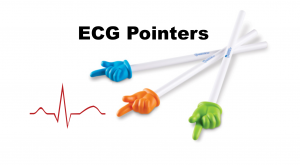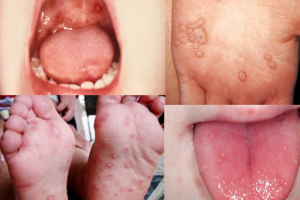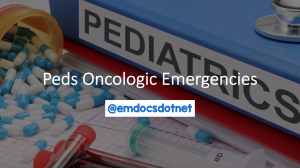Authors: Rahul Ramraj, MD (Emergency Medicine Resident Physician, Zucker School of Medicine/Northwell); Daniel Jafari, MD MPH (Assistant Professor of Emergency Medicine and Surgery, Zucker School of Medicine, Hofstra Northwell) // Reviewed by: Sophia Görgens, MD (EM Physician, BIDMC, MA); Cassandra Mackey, MD (Assistant Professor of Emergency Medicine, UMass Chan Medical School); Alex Koyfman, MD (@EMHighAK)
Welcome to EM@3AM, an emDOCs series designed to foster your working knowledge by providing an expedited review of clinical basics. We’ll keep it short, while you keep that EM brain sharp.
A 65-year-old male with a past medical history of chronic obstructive pulmonary disease on 2 liters per minute (LPM) nasal cannula at baseline, hypertension, hyperlipidemia, and polypectomy presents to the ED with 2 days of worsening shortness of breath, pleuritic chest pain, persistent fevers, and productive coughs with occasional hemoptysis. He reported having a COVID-19 infection 3 weeks ago but felt better 1-2 weeks ago. Four days ago, he presented to the ED for a COPD exacerbation. He is on his last day of a 5-day course of azithromycin 250 mg and prednisone 40 mg. He is compliant with his home medications including albuterol and inhaled corticosteroids. He is a retired farmer who lives with his wife and pet dog at home. On chart review, a sputum culture collected during a recent hospital visit grew a species of Aspergillus.
Vital Signs: HR 105, RR 24, SpO2 93% on 6 LPM NC, BP 143/88, T 101.1F
Physical Exam: increased work of breathing and slightly diminished breath sounds in the right mid-upper lung field
Lab Work: leukocytosis, blood/sputum/urine cultures (sent)
Chest X-ray: right lung nodules with no lobar consolidation
CT Chest:

Question: What medication should be considered for the most likely diagnosis?
Answer: voriconazole or isavuconazole for Invasive Pulmonary Aspergillosis (IPA)
Explanation: This patient has concern for IPA due to multiple risk factors including COPD history, recent COVID-19 infection, use of inhaled/oral corticosteroids, and a recent sputum culture that grew Aspergillus species (spp.). Chest x-ray lacks the sensitivity to detect IPA. The CT chest above shows a halo sign – a nodule with surrounding ground-glass opacities – representing local hemorrhage at the site of fungal infection. This is characteristic of IPA and other angio-invasive pathogens such as pseudomonas. Empiric treatment with voriconazole 6 mg/kg twice daily intravenously for 2 doses should be started immediately based on Infectious Disease Society of America (IDSA) guidelines. Alternate treatments include isavuconazole and liposomal amphotericin B. The most appropriate disposition for this patient is admission to an ICU due to increasing oxygen requirements, high mortality rates of IPA, and IDSA recommendation for bronchoscopy with lavage/tissue sampling. An urgent infectious disease consult is also warranted due to voriconazole therapeutic level monitoring and high azole resistance rates among Aspergillosis spp.
Introduction
Fungal infections are an increasing global public health concern as high-risk patient populations continue to grow: 1,2
- High Risk Populations: chronic lung disease (i.e. COPD, cystic fibrosis), HIV/AIDS, cancer, immunosuppressed (i.e. organ transplants), liver or kidney disease, broad-spectrum antibiotics use, and critically ill patients in the hospital/ICU
Epidemiology:
- Superficial fungal infections – affects 2 billion individuals worldwide 2
- Invasive Fungal Infections (IFIs) – 1.9 million patients with acute IFIs per year globally 3
- >1.5 million deaths per year attributed to all fungal diseases globally 3,4
World Health Organization (WHO) developed the first fungal priority pathogens list (WHO FPPL) in 2022 based on pathogen impact on public health and management challenges 1
Table 1: World Health Organization (WHO) Fungal Priority Pathogen List. 1

WHO Critical Priority Fungal Pathogens
- Cryptococcus neoformans
- Globally distributed, found in soil/wood/trees 1
- C. neoformans mortality: 41-61% (2023) 1,3
- Invasive Cryptococcus spp. accounts for 20% of all IFIs 3
- Specific Risk Factors: HIV/AIDS (#1 risk factor), organ transplant 1
- Candida auris
- Globally distributed, nosocomial infection and hospital outbreaks 1
- Candida spp. mortality: 42-63% 5
- Invasive Candida spp. accounts for 70% of all IFIs 3
- Specific Risk Factors: hospital stay (>10-15 days), mechanical ventilation, catheters, total parenteral nutrition (TPN) 1
- Aspergillus fumigatus
- Globally distributed, ubiquitous with high azole resistance 1
- fumigatus mortality: 40-90% (2023) 2,3
- Invasive Aspergillus spp. accounts for 10% of all IFIs 3
- Specific Risk Factors: hematopoietic stem cell transplantation (HSCT), chronic lung disease, corticosteroid therapy, viral infections 1
- Candida albicans
- Globally distributed, found commonly in human microbiota 1
Clinical Presentation – most common ED presentations
Cryptococcal spp. 1,6-8
- Pulmonary Cryptococcosis: cough, non-specific respiratory symptoms
- Disseminated Cryptococcosis:
- Skin: pustular/papules/ulcerated skin lesions are common
- Cryptococcal Meningitis (high mortality): absent/low grade fever, headaches, progressive decline in mental status; later in the course – blurred vision, confusion, and agitation/depression occurs due to cerebral edema
- Immunocompromised: more severe, rapidly progressive symptoms

Candida spp. 1,5,9-11
- Cutaneous Candidiasis: itchy, bright red rash involving skin folds with small pustules
- Oral Candidiasis: thrush (white-yellow non-scrapable rash on mucosa), angular cheilitis (redness/soreness with cracking at corners of the mouth)
- Vaginal Candidiasis: genital itching/burning with white “cottage cheese” discharge
- Disseminated Candidiasis: candidemia (blood), endophthalmitis, peritonitis, endocarditis, and meningitis

Evaluation/Diagnosis
Diagnostic criteria of proven IFIs include histopathological evidence or positive fungal culture(s) from > 1 sterile sites (blood, CNS – NOT respiratory specimen or urine specimen).5 However, due to high IFI mortality rates, empiric treatment should be started in the ED when there is a high index of suspicion based on risk factors/prior history, clinical signs/symptoms (previous section), and/or imaging in the ED. The non-culture-based diagnostic tests discussed below expedite the process of diagnosing IFIs.
Cultures
- Sputum cultures – recommended for Aspergillus spp., not Candida spp.
- Blood cultures
- Yeasts (up to 5 days to result) = sensitivity (50-95%) 3
- Molds (up to 4 weeks to result) = sensitivity (1-5%) 3
- Urine cultures – cryptococcal spp. involvement of prostate 7
Non-Culture-based Tests – faster than cultures, not available in all institutions
- (1→3)-β-D-Glucan detection – serum, cerebrospinal fluid (CSF), or bronchioalveolar lavage (BAL) 14,15
- 80-81% sensitive, 78-80% specific – studies of invasive Candida/Aspergillus
- Fungitell: FDA-cleared and CE marked rapid in vitro diagnostic screening test for IFI (including Candida, Aspergillus and Pneumocystis)
- Polymerase Chain Reaction (PCR) – serum, BAL, or CSF 14,15
- 73% sensitive, 95% specific – studies of Candida
Microscopy/Histopathology of tissue biopsies (gold standard) 3,14
Cryptococcal-specific Diagnostics 7,8
- Serum cryptococcal antigen by lateral flow assay (invasive cryptococcal infection)
- CT head: hydrocephalus, cryptococcomas (lung or CNS, variable-enhancing lesion)
- Lumbar Puncture: elevated opening pressure >20 cm H2O, elevated CSF protein, mononuclear cell pleocytosis (abnormal increased cell count)
- India Ink Test (CSF)
- Cryptococcal Antigen Latex Agglutination (CALA) Test (CSF)
Candida-specific Diagnostics 9,11,14,15
- Vaginal candidiasis: wet mount with saline and 10% potassium hydroxide
- Invasive Candidiasis Infection
- Mannan/anti-mannan antigen – serum (invasive candidal infection)
- Dilated ophthalmologic exam, echocardiography, endoscopy
- Sputum/BAL cultures are not recommended – difficult to distinguish between respiratory colonization and invasive candidal infection
Aspergillus-specific Diagnostics 13-16
- Galactomannan antigen – serum or BAL (invasive aspergillus infection)
- CT chest: characteristic of IPA and other angio-invasive pulmonary pathogens
- Halo sign: >1cm lung nodule with surrounding ground-glass opacities representing local hemorrhage
- Air-crescent sign: crescent-shaped collection of air that separates a mass from the wall of a lung cavity, representing pulmonary necrosis (late finding)
- Wedge-shaped lung infarcts
- Bronchoscopy with BAL +/- lung biopsy: BAL PCR to rule out invasive aspergillosis (negative predictive value > 95%) and lung biopsy for histopathologic confirmation

Treatment
Overview of types of antifungals 2,3,17
- Azoles – imidazoles (i.e. miconazole, clotrimazole, ketoconazole), triazoles (i.e. fluconazole, isavuconazole, itraconazole, voriconazole), tetrazoles
- Echinocandins – caspofungin, anidulafungin, and micafungin
- Anti-Metabolites/Pyrimidines – 5-fluorouracil, flucytosine
- Polyenes – amphotericin B (amp B – liposomal, lipid complex, colloidal dispersion), nystatin, natamycin
- Allylamines – naftifine and terbinafine
Cryptococcal spp. 1,6-8
- Isolated pulmonary cryptococcosis (mild): fluconazole
- Severe/disseminated cryptococcosis: liposomal amp B + flucytosine
- severe pulmonary cryptococcosis, skin inoculation, cryptococcal meningitis
- HIV patients with CD4 < 200 living in high endemic areas – empirically treat with fluconazole
Candida spp. 1,11
- Cutaneous candidiasis: azoles (miconazole or clotrimazole)
- Oral candidiasis: clotrimazole troches (lozenges) or miconazole buccal tablet
- Vaginal candidiasis: topical or oral fluconazole (equal efficacy)
- Esophageal candidiasis: oral fluconazole
- Candidemia: echinocandins (caspofungin, micafungin, or anidulafungin)
- Alternate: azoles (concomitant treatment or de-escalation if clinically stable)
- Critically ill patients with suspicion for invasive candidiasis – empirically treat with echinocandins (caspofungin or micafungin); alternates (fluconazole or amp B)
Aspergillus spp. 1,13,16
- Allergic aspergillus sinusitis: polypectomy, sinus washout, oral triazoles (refractory)
- ABPA: itraconazole or voriconazole (if asthma exacerbation)
- Aspergilloma: observe (if asymptomatic and no enlarging cavity), resection (if symptomatic), peri-/post-op triazoles or echinocandins not required
- Invasive Aspergillosis: triazoles (voriconazole, itraconazole, and posaconazole)
- Alternate: lysosomal amp B
- Critically ill patients with neutropenia and suspicion for invasive aspergillosis – empirically treat with voriconazole or posaconazole
Table 2: Systemic antifungal treatments for Cryptococcal spp., Candida spp., and Aspergillus spp. Note that many of the above antifungal dosages, frequencies, and lengths of treatment vary widely between institutions. Data extracted and consolidated from UpToDate® LexidrugTM. IV = intravenous and PO = oral.

Treatment challenges
- Antifungal Resistance: drug-resistant pathogens in invasive fungal infections are responsible for >50% mortality rate 1,2,17
- Antifungal Toxicity: eukaryotic nature of microbe and human host with more similar biochemical pathways/organelles 2,14,18
- Hepatotoxicity, nephrotoxicity, infusion-related reactions, electrolyte derangements, bone marrow suppression, gastrointestinal discomfort, rashes
Evidence for Untargeted (prophylactic/empiric) Antifungal Treatment – no ED studies to date
- Non-neutropenic, critically ill patients (ICU, recent invasive procedure, septic shock or severe sepsis) with concern for IFI (* = based on symptoms/signs or prior fungal infections):
- Significant reduction in incidence of IFIs (45%, p = 0.0001, 17 randomized studies, n = 2024) without any significant difference in total (all-cause) mortality (p = 0.36, 19 randomized studies, n = 2374) 5,19
- Specifically, empiric fluconazole – significant reduction in incidence of IFIs (10 randomized studies, p = 0.001) 5,19
- Cancer patients with profound neutropenia and prolonged fevers (<500 neutrophils/mm3, ≥10 days) with concern for IFIs* – empiric amp B significantly decreased total mortality (32 trials, n = 4287) 5,20,21
- Solid organ transplant patients (specifically liver, lung) with concern for IFIs* 5
- Critically ill HIV/AIDS patients with concern for IFIs* 5
Table 3: Common ED fungal pathogens with key details including endemic region, clinical presentation, risk factors, and treatment. Data extracted and consolidated from multiple sources.22-28

Disposition
Consult infectious disease for all IFI patients to ensure appropriate antifungal stewardship. All IFI patients should be admitted to the hospital due to high mortality rates, high prevalence of antifungal resistance, concern for antifungal toxicity requiring routine labs/titers, and empiric/supportive care while awaiting diagnostic testing. IFI patients may require ICU level of care as they often present in septic shock, have increasing oxygen requirements, and may also require urgent bronchoscopy with lavage/tissue sampling for definitive diagnosis.
Clinical Pearls
– Order/perform non-culture-based tests to aid in expedited diagnosis of invasive fungal infections if there is high suspicion – β-D-Glucan detection (i.e. Fungitell), PCR (i.e. BioFire FilmArray System), pathogen-specific antigen tests (cryptococcal antigen by lateral flow assay, mannan/anti-mannan, galactomannan), and lumbar puncture with India Ink Test and/or Cryptococcal Antigen Latex Agglutination (CALA) Tests.
– Consider empiric antifungals when there is high clinical suspicion for invasive fungal infections based on risk factors, prior fungal infection history, signs/symptoms, and imaging findings (low-moderate quality evidence).
– Consider empiric antifungals in the following patient populations when critically ill – HIV/AIDS patients, solid organ transplant patients, and cancer patients with prolonged neutropenia (<500 neutrophils/mm3, ≥10 days) (higher quality evidence).

A 28-year-old woman who is 32 weeks pregnant is seen in an emergency department in Phoenix for fever and cough. She is well appearing with otherwise normal vital signs. A chest X-ray shows a small right upper lobe pneumonia with right hilar adenopathy. Which of the following is the most appropriate treatment for this patient?
A) Amoxicillin-clavulanate
B) Fluconazole
C) Fluconazole plus amphotericin B
D) No treatment indicated
Correct answer: B
Primary pulmonary coccidioidomycosis, also known as Valley fever, is a fungal infection mostly found in the southwestern US. It is acquired by inhaling spores from mold that grows beneath the desert floor. When pulmonary coccidioidomycosis is suspected outside of the southwestern US, a travel history is important, as symptoms have a 1- to 3-week latency period. While more than one-half of coccidioidomycosis infections may be asymptomatic, typical pulmonary symptoms include cough, chest pain, and dyspnea. Extrapulmonary manifestations of primary pulmonary coccidioidomycosis include fever, night sweats, weight loss, and fatigue. Rheumatologic and skin manifestations can also be seen, including arthralgias, erythema nodosum, and erythema multiforme, and these symptoms do not represent systemic disease.
The chest X-ray findings in pulmonary coccidioidomycosis are often normal, even in patients who have pulmonary symptoms, but it can show classic lobar pneumonia with ipsilateral hilar adenopathy, though coccidioidal pneumonia is more likely to be found in the upper lobes. Chest CT may show diffuse reticulonodular pneumonia. The diagnosis of coccidioidal pneumonia is based on serologic IgM testing with or without sputum culture. The treatment of pulmonary coccidioidomycosis is based on the severity of disease and the likelihood of developing severe or complicated disease. Severe disease is defined as infiltrates in both lungs or more than one-half of one lung, symptoms present > 3 weeks, 10% loss of body weight, or a high antibody titer. Those with an increased likelihood of severe disease include those who are immunosuppressed and pregnant individuals in the second and third trimesters. Immunocompetent and nonpregnant individuals who do not have severe disease generally should not be treated. Immunocompetent, nonpregnant patients with severe disease should generally receive fluconazole 400 mg daily for 12 weeks. Amphotericin B is commonly added for those who are critically ill and require ICU-level care. Pregnant patients in the second or third trimester with any severity of disease, as in this case, should generally be treated with fluconazole.

Amoxicillin-clavulanate (A) is appropriate antibiotic therapy for community-acquired pneumonia and may be an appropriate component of empiric coverage for this patient while Coccidioides serology is obtained. However, upper lobe pneumonia with ipsilateral hilar adenopathy in the southwestern desert should make one consider coccidioidomycosis, which requires antifungal treatment in this pregnant patient.
Amphotericin B (C) is a good treatment option over azoles for pregnant patients since azoles are thought to be teratogenic. However, amphotericin should be reserved for critically ill patients with coccidioidomycosis and is only used during the first trimester of pregnancy because of its safety profile. This patient is in her third trimester and thus is at high risk for developing severe pulmonary coccidioidomycosis, even if her current disease is mild to moderate.
Treatment with fluconazole is indicated, as opposed to no treatment (D), for all pregnant patients in the second or third trimester who develop pulmonary coccidioidomycosis.
Further Reading:
- World Health Organization, Sati H, Alastruey-Izquierdo A, et al. WHO fungal priority pathogens list to guide research, development and public health action. World Health Organization;
- Munzen ME, Garcia ADG, Martinez LR. An update on the global treatment of invasive fungal infections. Future Microbiology. 2023;18(15):1095-1117. doi:10.2217/fmb-2022-0269 https://iris.who.int/bitstream/handle/10665/363682/9789240060241-eng.pdf?sequence=1.
- Fang W, Wu J, Cheng M, et al. Diagnosis of invasive fungal infections: challenges and recent developments. Journal of Biomedical Science. 2023;30(1). doi:10.1186/s12929-023-00926-2
- Rayens E, Norris KA. Prevalence and healthcare burden of fungal infections in the United States, 2018. Open Forum Infectious Diseases. 2022;9(1). doi:10.1093/ofid/ofab593
- Cortegiani A, Russotto V, Maggiore A, et al. Antifungal agents for preventing fungal infections in non-neutropenic critically ill patients. Cochrane Library. 2016;2018(12). doi:10.1002/14651858.cd004920.pub3
- Chang C, Harrison T, Bicanic T, et al. Global Guideline for the Diagnosis and Management of Cryptococcosis: an initiative of the ECMM and ISHAM in cooperation with the ASM. The Lancet Infectious Diseases. 2024;24(8):e495-e512. doi:10.1016/S1473-3099(23)00731-4
- Vergidis P. Cryptococcosis. Merck Manual Professional Edition. https://www.merckmanuals.com/professional/infectious-diseases/fungi/cryptococcosis. Published September 9, 2023.
- Global Guideline for the Diagnosis and Management of Cryptococcosis: an initiative of the ECMM and ISHAM in cooperation with the ASM. The Lancet – Infectious Disease. 2024;24(8):e495-e512. doi:10.1016/S1473-3099(23)00731-4
- Aaron DM. Candidiasis (Yeast infection). Merck Manual Consumer Version. https://www.merckmanuals.com/home/skin-disorders/fungal-skin-infections/candidiasis-yeast-infection. Published September 21, 2023.
- R AN, Rafiq NB. Candidiasis. StatPearls – NCBI Bookshelf. https://www.ncbi.nlm.nih.gov/books/NBK560624/. Published May 29, 2023.
- Pappas PG, Kauffman CA, Andes DR, et al. Clinical Practice Guideline for the Management of Candidiasis: 2016 update by the Infectious Diseases Society of America. Clinical Infectious Diseases. 2015;62(4):e1-e50. doi:10.1093/cid/civ933
- Symptoms of Aspergillosis. Aspergillosis. https://www.cdc.gov/aspergillosis/signs-symptoms/index.html. Published April 24, 2024.
- Townsend L, Martin-Loeches I. Invasive aspergillosis in the intensive care unit. Diagnostics. 2022;12(11):2712. doi:10.3390/diagnostics12112712
- Paramythiotou E, Frantzeskaki F, Flevari A, Armaganidis A, Dimopoulos G. Invasive fungal infections in the ICU: How to approach, how to treat. Molecules. 2014;19(1):1085-1119. doi:10.3390/molecules19011085
- Johnson MD, Lewis RE, Ashley ESD, et al. Core recommendations for Antifungal stewardship: A statement of the Mycoses Study Group Education and Research Consortium. The Journal of Infectious Diseases. 2020;222(Supplement_3):S175-S198. doi:10.1093/infdis/jiaa394
- Patterson TF, Thompson GR, Denning DW, et al. Practice Guidelines for the Diagnosis and Management of Aspergillosis: 2016 update by the Infectious Diseases Society of America. Clinical Infectious Diseases. 2016;63(4):e1-e60. doi:10.1093/cid/ciw326
- Rabaan AA, Sulaiman T, Al-Ahmed SH, et al. Potential Strategies to control the risk of antifungal resistance in humans: A Comprehensive review. Antibiotics. 2023;12(3):608. doi:10.3390/antibiotics12030608
- Vergidis P. Antifungal medications. Merck Manual Professional Edition. https://www.merckmanuals.com/professional/infectious-diseases/fungi/antifungal-medications. Published September 9, 2023.
- Cortegiani A, Russotto V, Raineri SM, Gregoretti C, Giarratano A. Should we Administer Antifungal Drugs Before the Diagnosis of Invasive Fungal Infection in Non-Neutropenic Critically Ill Patients? Türk Anestezi Ve Reanimasyon Dergisi. 2017;44(6):276-278. doi:10.5152/tjar.2016.0010
- Gøtzsche PC, Johansen HK. Routine versus selective antifungal administration for control of fungal infections in patients with cancer. Cochrane Library. 2014;2017(3). doi:10.1002/14651858.cd000026.pub2
- Maertens, J., Lodewyck, T., Donnelly, J. P., Chantepie, S., Robin, C., Blijlevens, N., Turlure, P., Selleslag, D., Baron, F., Aoun, M., Heinz, W. J., Bertz, H., Ráčil, Z., Vandercam, B., Drgona, L., Coiteux, V., Llorente, C. C., Schaefer-Prokop, C., Paesmans, M., Ameye, L., … Infectious Diseases Group and the Acute Leukemia Group of the European Organization for Research and Treatment of Cancer (2023). Empiric vs Preemptive Antifungal Strategy in High-Risk Neutropenic Patients on Fluconazole Prophylaxis: A Randomized Trial of the European Organization for Research and Treatment of Cancer. Clinical infectious diseases: an official publication of the Infectious Diseases Society of America, 76(4), 674–682. https://doi.org/10.1093/cid/ciac623
- Le T, Bhushan V, Sochat M, Vaidyanathan V. First aid for the USMLE Step 1. 2020th ed. McGraw Hill; 2020.
- Goldstein A, Goldstein B. Dermatophyte (tinea) infections. UpToDate. https://www.uptodate.com/contents/dermatophyte-tinea-infections?search=Dermatophyte%20%28Tinea%29%20Infections&source=search_result&selectedTitle=1%7E132&usage_type=default&display_rank=1#H1. Published November 21, 2024.
- Goldstein B, Goldstein A. Tinea versicolor (pityriasis versicolor). UpToDate. https://www.uptodate.com/contents/tinea-versicolor-pityriasis-versicolor?search=Tinea%20versicolor%20%28pityriasis%20versicolor%29&source=search_result&selectedTitle=1%7E27&usage_type=default&display_rank=1#H1. Published July 24, 2024.
- Kauffman, C., Miceli M. Clinical features and diagnosis of sporotrichosis. UpToDate. https://www.uptodate.com/contents/clinical-features-and-diagnosis-of-sporotrichosis?search=Clinical%20features%20and%20diagnosis%20of%20sporotrichosis&source=search_result&selectedTitle=1%7E40&usage_type=default&display_rank=1#H1. Published September 26, 2024.
- Kauffman, C., Miceli M. Treatment of sporotrichosis. UpToDate. https://www.uptodate.com/contents/treatment-of-sporotrichosis?search=Treatment%20of%20sporotrichosis&source=search_result&selectedTitle=1%7E40&usage_type=default&display_rank=1#H1. Published September 23, 2024.
- Cox G. Mucormycosis (zygomycosis). UpToDate. https://www.uptodate.com/contents/mucormycosis-zygomycosis?search=Mucormycosis%20%28zygomycosis%29&source=search_result&selectedTitle=1%7E71&usage_type=default&display_rank=1#H1. Published August 25, 2023.
- Thomas, C., Limper A. Treatment and prevention of Pneumocystis pneumonia in patients without HIV. UpToDate. https://www.uptodate.com/contents/treatment-and-prevention-of-pneumocystis-pneumonia-in-patients-without-hiv?search=Treatment%20and%20prevention%20of%20Pneumocystis%20pneumonia%20in%20patients%20without%20HIV&source=search_result&selectedTitle=1%7E150&usage_type=default&display_rank=1#H1. Published July 17, 2024.








